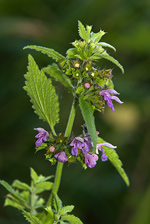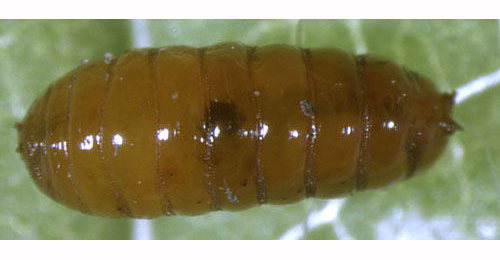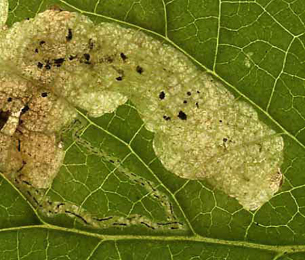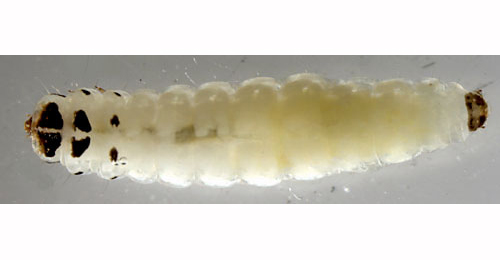|
||||||
|
BALLOTA. Black Horehound. [Lamiaceae] |
|
|
Two species of Ballota are recorded in Britain. These include Black Horehound (B. nigra). Four British miners are recorded on Ballota. A key to the European miners recorded on Ballota is provided in Bladmineerders van Europa. |
 Black Horehound Ballota nigra |
Key for the identification of the known mines of British |
1a > Leaf-miner: A distinctive mine primarily above mid-rib, with irregular short lateral offshoots into leaf blade. Pupation external (Spencer, 1972: 51 (fig. 172), 55; Spencer, 1976: 270, 271 (fig. 486)). Branched, whitish, upper-surface corridor; main axis overlying the midrib; side branches overlying the main lateral veins. (In Campanula and Phyteuma the mine is much less branched, sometimes nothing more than a corridor on top of the midrib). Frass in rather long strings. Usually the mines begins as a long and narrow, shallow, tortuous lower-surface corridor that ends upon the midrib but otherwise is not associated with the leaf venation. Often this initial corridor is filled with callus, and then even less conspicuous. Pupation outside the mine. A linear mine on the upper surface, usually following the midrib and showing side branches along the veins. The frass is in strings. |
|
Liriomyza strigata (Meigen, 1830) [Diptera: Agromyzidae]. |
| 1b > Leaf-miner: An
initially linear mine, which at second instar develops into a large
whitish blotch with conspicuous black frass. The early linear mine
is frequently entirely enveloped by the blotch but is detectable
by the alternate irregular strips of frass. Pupation external (Spencer,
1976: 158).
The first part of the mine consists of a long, slender upper-surface corridor. After the first moult this changes into a large primary blotch without feeding lines. Frass in the corridor in short, somewhat angular thread fragments, towards the end even in grains. Frass arranged less closely along the sides than in A. lamii. Pupation outside the mine. The frass is conspicuous in the mine and the mine is initially linear, then develops into a white blotch, often enveloping this early mine. |
|
Amauromyza morionella (Zetterstedt, 1848) [Diptera: Agromyzidae]. |
1c > Leaf-miner: A linear-blotch mine, first instar mine is linear, later developing into a conspicuous white blotch. Frass greenish diffused (Spencer, 1972b: 46, 47 (fig. 138); Spencer, 1976: 166). The mine begins with a long, upper-surface, slender corridor. After a moult the larva changes its behaviour, and makes a large, upper-surface primary blotch without apparent feeding lines. Often the blotch overruns more or less the initial corridor. Frass in the corridor liquified to form a wide green band, with a few tiny black granules along the sides. Pupation outside the mine. A narrow gallery leading to a largish blotch on the upper surface. Frass is green and indistinct in the gallery - small grains may be seen at the gallery edge. |
 Amauromyza labiatarum puparium Image: © Willem Ellis (Bladmineerders van Europa) |
|
Amauromyza labiatarum (Hendel, 1920) [Diptera: Agromyzidae]. |
1d > Leaf-miner: Initially a long, slim corridor, the frass alternating on either the side of the corridor. After moulting, the larva broadens the mine and the frass is less regular. Pupation external. |
 Mine of Amauromyza lamii on Stachys sylvatica Image: © Willem Ellis (Bladmineerders van Europa) |
|
Amauromyza lamii (Kaltenbach, 1858) [Diptera: Agromyzidae]. |
1e > Leaf-miner and case-bearer: The mines are large and obvious on the upper side of the leaf, betraying the larva or larvae on the lower side. Cases are broad and flat - being very hairy from the texture of the leaf. Immediately after emergence the larva makes a full depth, quickly widening, corridor, with frass as small grains in a broad central band. Finally results in a blotch of 2 x 5 mm, from which the young case is cut. The fully developed case is a hairy, greyish brown to silver grey lobe case case of about 1 cm long, with a clearly laterally compressed end; the mouth angle is about 90°. The case is difficult to separate from that of C. ochripennella. |
 Coleophora lineolea larva, dorsal Image: © Willem Ellis (Bladmineerders van Europa) |
|
Coleophora lineolea (Haworth, 1828) [Lepidoptera: Coleophoridae]. |
| Last updated 01-Jul-2019 Brian Pitkin | ||
